Australia
 From Conservapedia
From Conservapedia | Commonwealth of Australia | |
|---|---|
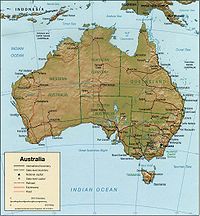 | |
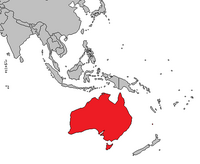 | |
 |
 |
| Flag | Coat of Arms |
| Capital | Canberra |
| Government | Constitutional monarchy |
| Language | English (official) |
| Monarch | King Charles III |
| Prime minister | Anthony Albanese |
| Area | 2,988,888 sq mi |
| Population | 25,500,000 (2020) |
| GDP | $1,350,000,000,000 (2020) |
| GDP per capita | $52,941 (2020) |
| Currency | Australian dollar |
The Commonwealth of Australia is an independent nation that occupies the continent of Australia, with its west coast on the Indian Ocean, east coast on the Pacific Ocean facing New Zealand, southern coast on the Southern Ocean facing Antarctica, and northern coast facing Indonesia and Papua New Guinea. Australia is considered geographically as part of Oceania, but has been establishing its place politically and commercially in Southeast Asia.
Politically, Australia combines the structures of a democratic political system with a governing culture that is authoritarian or even fascist in many respects. It shifted towards Leftism as the result of enacting gun control in the wake of an isolated mass shooting in 1996, the Port Arthur massacre. In contrast, the United States has remained more conservative by rejecting that totalitarian approach urged by the liberal media.
The continuing influence of atheistic, imperialistic England is felt in Australia as the capital of its Northern Territory is named "Darwin", after the racist British pseudo-scientist.
In October 2021, under Australia's mostly leftwing government, citizens and residents were held prisoner in their own country by the government. Masks and vaccines were mandatory, and citizens even had to report their whereabouts to government. The world's top tennis player was detained and deported in January 2022 and thereby prevented from competing in the Australian Open, merely because he was not vaccinated.
Australia is the #3 producer of gold in the world, narrowly behind only the much larger China and Russia,[1] and its mining of that and many additional rare minerals make it an attractive target of aggression by China.[2]
Contents
- 1 Geography
- 1.1 The States and Territories of Australia
- 1.2 Low density
- 1.3 Weather
- 1.4 Flora and fauna
- 2 People
- 2.1 Demographics
- 2.2 Aborigines and Torres Straits Islanders
- 2.3 Immigrants
- 2.3.1 Illegal immigration
- 2.4 Recent trends
- 2.4.1 COVID-19 pandemic
- 2.4.1.1 Genetic experiments on children
- 2.4.1.2 Totalitarian lockdowns
- 2.4.1.3 Confiscation of property
- 2.4.2 Refugees
- 2.4.3 Religion
- 2.4.4 Culture
- 2.4.5 Sports
- 2.4.6 Tourism
- 2.4.7 Gun control
- 2.4.1 COVID-19 pandemic
- 3 Government
- 3.1 Voting
- 3.2 Terms
- 3.3 Parliamentary political parties
- 3.4 Principal Government Officials
- 3.5 Political Conditions
- 3.6 ANZUS and Defense
- 4 Economy
- 4.1 Exports and Imports
- 4.2 Strong growth
- 4.3 Businesses
- 4.4 Unemployment
- 4.5 Resources
- 4.5.1 Energy
- 4.5.2 Comparing Australian and U.S. Economic and Health statistics
- 5 History
- 6 See also
- 7 Bibliography
- 7.1 References
- 7.2 Guides
- 7.3 Economics and business
- 7.4 Environment and Geography
- 7.5 History
- 7.6 International Relations and Military
- 7.7 Culture and society
- 8 Primary sources
- 9 External links
- 10 References
Geography[edit]

Australia is the only country to occupy an entire continent,[3] the smallest of the planet's seven continents.[4] It is 2,400 miles, (3,860 km) from east to west and 2,000 miles (3,220 km) from north to south, and covers an area of 2,967,877 sq miles (7,686,810 km2). The Australian coastline is 22,812 miles long (36,735 kilometers), roughly the size as the mainland 48 states of the USA.
The States and Territories of Australia[edit]
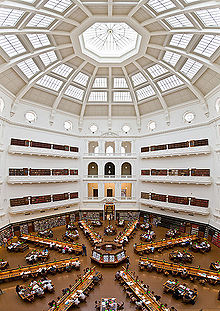
Australia has six states and two internal territories. The states are:
- New South Wales
- Victoria
- Queensland
- Western Australia
- South Australia
- Tasmania
The internal territories are:
- The Northern Territory (responsible government since 1978)
- Australian Capital Territory (responsible government since 1988) which is the location of Australia's capital city, Canberra.
The external territories are:
- Christmas Island
- Norfolk Island
- Australian Antarctic Territory
- Coral Sea Islands
- Ashmore and Cartier Islands
- Cocos (Keeling) Islands
- Heard Island and McDonald Islands
Low density[edit]
80% of Australia's population live on the coast line. It is one of the world's most sparsely populated countries (2.7 people per square kilometre).[5]
Weather[edit]
Weather extremes are fairly common in parts of Australia with temperatures sometimes measured into the high 40s Celsius (45 degrees Celsius = 113 degrees Fahrenheit). The city of Darwin was heavily damaged by Cyclone Tracy on Dec. 25, 1974, killing 66 people, and destroying 80% of the buildings. Darwin's utilities were knocked out and 35,000 people were evacuated.
Bush fires often ravage the southern states - one of the worst occurring on Ash Wednesday in 1983 when over 2,000 homes were destroyed and over 70 people lost their lives in Victoria and South Australia. In 2009 severe fires hit much of Victoria, worsened by hot dry winds and a severe drought.
Water is somewhat scarce and some cities have forms of water restrictions in place, especially during the Summer months.
Flora and fauna[edit]
Australia is noted for its unique biodiversity. Many animals are found only in Australia, the most well known examples are the group of marsupials (kangaroos, wombats, wallabies and koalas), and the only two monotremes, the platypus and the echidna. Examples of plants that are native to Australia are the banksia, yellow wattle and gum tree.
Current evolutionary studies indicate that Australia's unique wildlife is the result of Australia becoming an island, being cut off from the Asian land bridge between 40,000 and 250,000 years ago on the uniformitarian timescale. Contrary to that, young earth creation scientists assert that the entire subset animals that are all the Earth's species of kangaroos, wallabies and other similar creatures travelled together to Australia following the Great Flood. It is not known whether they communicated the idea amongst themselves or all went the same way by chance.
People[edit]
Demographics[edit]

Although Australia has scarcely more than three people per square kilometer, it is one of the world's most urbanized countries. Less than 2.5% of the population lives in remote or very remote areas.
- Population (2017 est.): 24.7 million.[6]
- Annual population growth rate: 1.7%.
- Ethnic groups: European 92%, Asian 6%, Aboriginal 2%.
- Religions (2021): Catholic 20%, Protestant 18%, other Christian 5.8%, other non-Christian 4.5%, Buddhist 2.4%, Islam 3.2%, no religion 38.9%, and not stated 7.2%.
- Languages: English.
- Education: Years compulsory—to age 16 in all states and territories except New South Wales and the Northern Territory where it is 15, and Western Australia where it is 17. Literacy—over 99%.
- Health: Infant mortality rate—4.7/1,000. Life expectancy—males 78 yrs., females 83 yrs.
- Work force (10.8 million): Agriculture—3.3%; mining—1.5%; manufacturing—9.8%; retail trade—11.3%; public administration, defense, and safety—6%; construction—9.2%
Aborigines and Torres Straits Islanders[edit]
Australia's indigenous inhabitants are a hunting-gathering people collectively referred to today as Aborigines and Torres Straits Islanders (ATSI). Although evolutionary theorists purport that native Australians arrived more than 60,000 years ago, this view rejects the Biblical account of Noah as historic and is based on the old-earth paradigm. Aboriginal people arrived in Australia some time after the events at the Tower of Babel in Genesis 11. Although their technical culture remained static—depending on wood, bone, and stone tools and weapons—their spiritual and social life was highly complex. Most spoke several languages, and confederacies sometimes linked widely scattered tribal groups. Indigenous population density ranged from one person per square mile along the coasts to one person per 35 square miles in the arid interior. When Captain James Cook claimed Australia for Great Britain in 1770, the native population is estimated to have numbered between 318,000 and 750,000 in as many as 500 tribes speaking many different languages. In 2006 the indigenous population was approximately 517,200, representing about 2.5% of the population. Since the end of World War II, the government and the public have made efforts to be more responsive to aboriginal rights and needs, most recently with Prime Minister Rudd's historic apology to the indigenous people in February 2008.
Immigrants[edit]
Immigration has been vital to Australia's development since the beginning of European settlement in 1788. Originally used as a prison for convicts, the discovery of gold in Victoria convinced many to come to Australia. For generations, most settlers came from the British Isles, and the people of Australia are still predominantly of British or Irish origin, with a culture and outlook similar to those of Americans. A "White Australia" policy operated from 1901 to the 1960s; it encouraged immigration by Europeans and blocked almost all other immigration.
Many of the Chinese who arrived in the late 19th century to work in the gold mines left voluntarily or were expelled. Likewise, most of the "Kanakas"—Polynesians—who came to work in the sugar fields were expatriated after 1901. Many Germans settled in South Australia, but those without Australian citizenship were put in camps during World War I and most were sent back to Germany after the war.
In 2017, the Australian government adopted measures to conduct extreme vetting of immigrants, particularly Muslims, to ensure that radical Islamists do not enter the country, and it reformed its H-1B visa.[7] In 2018, the government stated it would refuse to sign the UN global migration compact because of its negative effect on Australian sovereignty.[8] In November 2018, Prime Minister Scott Morrison promised he would reduce immigration levels,[9] and he implemented that promise in March 2019.[10] Because of Australia's conservative immigration policies, permanent migration in 2019 fell to the lowest level in a decade.[11] Australia's government advocated for integrating migrants into Australia's culture.[12]
Illegal immigration[edit]
In 1999, there was a surge in illegal immigration to Australia.[13] The Liberal (the conservative party) prime minister John Howard cracked down on illegal immigration and by 2002, there was virtually no illegal immigration.[13] In 2007, Kevin Rudd of the Labor party was elected prime minister, and because of his government's lenient immigration policy, the number of illegal immigrants skyrocketed, reaching over 20,000 people and 300 boats in the year 2013 alone.[13] However, the government did not acknowledge that its lax policies were the reason for the growth in illegal immigration.[13] In 2013, the Liberal Party was voted back into the government, and again instituted strict (and thus, controversial) policies again, and illegal immigration dropped to virtually zero, with only one boat arriving in 2014, and none in 2015.[13]
Australia continued enacting additional border security measures which resulted in all forms of migration falling even further by 2018.[14] Because of its immigration policies, Australia's migration levels reached a 10-year low in 2017.[15] In August 2018, Scott Morrison, who created the country's tough immigration policy, became prime minister.[16][17]
In 2019, facing a very thin Liberal Party majority, Australia's parliament undermined the country's tough immigration policies, though foreign countries such as Nauru took some steps to preserve it.[18] However, Prime Minister Scott Morrison's tough immigration policies helped him win the 2019 federal elections.[19] After the election, Australia's government refused to soften the policy.[20] It also succeeded in repealing some of the weakened policies pushed by Parliament earlier in the year.[21]
Recent trends[edit]
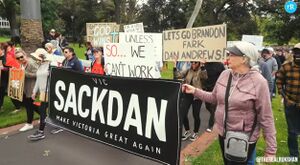
Since the end of World War II, Australia's population has more than doubled.
Non British/Irish immigration has increased significantly since World War II through an extensive, planned immigration program. Since 1945 around 6.6 million migrants have settled in Australia, including 690,000 refugee and humanitarian entrants. About 80% have remained; 24%--almost one in four—of Australians are foreign-born. Britain, Ireland, Italy, Greece, New Zealand, and the former Yugoslavia were the largest sources of post-war immigration, but New Zealand is closing on Britain as the largest source country for permanent migrants to Australia.
The barriers against Asians fell in the 1970s and thousands of immigrants from the Chinese diaspora resettled in Australia. Immigrants from India and the Philippines were numerous as well.
COVID-19 pandemic[edit]
- See also: CCP global pandemic
When the government of Australia requested an international investigation into the CCP coverup and the Wuhan Virology Lab, the official Chinese state media response was to derisively and dismissively call Australia the "gum stuck to the bottom of China's shoes".[22]
In response to the spread of the virus, Australia's leftwing fascist parties implemented some of the most stringent loss of freedoms and expansion of government power on the planet.[23] Fascist premier Gladys Berejiklian of the New South Wales Liberal Party ordered the most dracoian lockdown procedures on the planet.[24] Berejiklian was reportedly bribed and blackmailed by Big Pharma to force the “vaccines” on Aussies. As of October 2021, only 1,421 Aussies have been reported to have died after testing “positive” for COVID-19 over a 20 month period in a nation of 23 million. Berejiklian resigned under a cloud in a corruption probe.[25]
Genetic experiments on children[edit]
- See also: Nuremberg Code
Australia performed forced mRNA genetic experiments on 24,000 school children.[26][27]
Totalitarian lockdowns[edit]
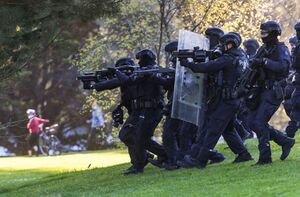
During the Chinese Communist Party pandemic beginning in 2020, Australian leftist totalitarian regimes at the provincial level imposed the most draconian measures against the population outside of the Peoples Republic of China. The population, having been disarmed, was powerless against state-sponsored tyranny. Leftwing fascist Premier of Victoria, Daniel Andrews, outlined the rules and regulations for opening society back up after almost a year of total lockdown. The futile attempt to block the COVID-19 virus through a policy known as “COVID-ZERO” was abandoned. The new approach was to open up society and the economy by forcing everyone to take the vaccine, and then allowing only the vaccinated to participate in the economy as varying percentages of the population are double-vaxxed, and admittedly, later, booster-vaxxed.
Vaccination passports or exemptions are required to work, shop, attend events and essentially live in the New World Order Premier Daniel Andrews created for the citizens of Victoria. The day after Andrews outlined the new rules – the working class, who were locked down and compliant to this point, finally had enough.
On September 20, 2021 a large group of members of the biggest trade union in Australia, the Construction, Forestry, Maritime, Mining and Energy Union (CFMEU), went to CFMEU headquarters to confront their leadership, CFMEU Secretary John Setka. Their demand was to have their voices heard and use the power of the trade union to stop the Victorian government overreach. The union members wanted their leadership to block the new vaccine mandate and stop the creation of a two-tiered society as outlined by fascist Premier Daniel Andrews.
However, regional union secretary John Setka turned a deaf ear to the concerns of his members and would not listen. Angry at his members Setka asked, “What do you want me to do, shut it down?“, meaning use the power of the union -strike if necessary- to push back against the government. The members said “yes”, exactly that. However, union boss Setka was unwilling as it appears he’s in alignment with the objectives of the socialist Premier. Steka surrounded himself with thugs and bodyguards while turning against hundreds of his own members. The police arrived and used rubber bullets, tear gas, and riot units to dispel the crowd.
In response to the defiant nature of the CFMEU trade union, Premier Dan Andrews announced he was shutting down the construction industry as punishment for their non-compliance. Simultaneously, union boss Setka then went on media to attack his own members calling them fascists, Nazis and worse. This only made the issues more explosive.
On September 21, 2021, the trade union members took to the streets in even larger numbers, now joined by blue-collar workers of all stripes who identify with the cause. Even workers who did not previously like the union members or their prior political tactics joined in common cause over the issue of COVID-19. Tens-of-thousands of non-union workers joined with the trade union protesters in solidarity.
Confiscation of property[edit]
Citizens were required to have their physical location scanned via a QR code on their phone. These checkpoints were to assist in controlling the COVID spread and were used for contact tracing throughout the past two years. However, the checkpoints and gateway compliance scans also registered your physical location; the consequence was an increased ability for police and COVID compliance officers to catch people violating the COVID rules. Ex: If you checked in at the grocery store, they knew how far from home you are, and the police could figure out if you violated your one hour of time outside the home at the next checkpoint.
The result of all this compliance monitoring was thousands of fines, civil citations for violating COVID rules. Thousands of people given thousands of fines that would need to be paid. The enforcement actions to collect these fines from the State Penalty and Enforcement Register (SPER) are quite extreme. Citizens with outstanding tickets had their driver’s licenses suspended; bank accounts frozen and seized; homes and property confiscated, as well as business licenses suspended for outstanding citations.[29]
Refugees[edit]
Australia's humanitarian and refugee program of about 13,000 per year is in addition to other immigration programs. In recent years, refugees from Africa, the Middle East, and Southwest Asia have comprised the largest element in Australia's refugee program.
Religion[edit]
Australia is a secular nation, in that it has no established religion associated with the Government. (Requires mathematic correction) According to the 2006 census, 64% of citizens consider themselves to be Christian, including 26% Roman Catholic, 19% Anglican, and 19% other Christian. Buddhists constitute 2.1% of the population, Muslims 1.7%, Hindus 0.7%, Jews 0.4%, and all others professing a religion 0.5%. Of Australia's 21 million people, about 1.5 million attend weekly religious services.[30] See also: Irreligion in Australia
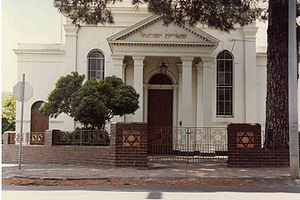
In 1911, during the first census, 96% identified themselves as Christian. In recent decades traditional Christian denominations have seen their total number and proportion of affiliates stagnate or decrease significantly, although from 2001 to 2006, the total number of Pentecostal and charismatic Christians increased by 12.9%. Over the past decade, increased immigration from Southeast Asia and the Middle East considerably expanded the numbers of citizens who identify themselves as Buddhists, Hindus, and Muslims, and increased the ethnic diversity of existing Christian denominations. Between 2001 and 2006, the numbers increased for Buddhists by 17% (to 418,000), Muslims by 21% (to 340,393), Jews by 6% (to 89,000), and Hindus by 55% (to 148,131). In 2006 approximately 18.7% of citizens considered themselves to have no religion, up from 17% in 2001, and 11.2% made no statement regarding religious affiliation. According to a 2002 survey, 23% of adults had participated in church or religious activities during the previous 3 months.
The Australian public school system is "free, secular and compulsory" with the secular meaning without favor to any particular religion. Schools are required to offer religious instruction at the primary level, but are not allowed to discriminate between religions. The state systems of a number of states offer studies in religion at the senior level.
There is a large Catholic school system in Australia with most parishes having their own primary school and many hundreds of Catholic high schools across the country. There are also a large number of independent schools founded by various religions or denominations of the Christian faith - some hold that religious background to be more important than others. All schools, state or religious, receive government funding, as funding is provided for every student that is an Australian resident.

At the time of European settlement, aboriginal inhabitants followed religions that were animistic, involving belief in spirits behind the forces of nature and the influence of ancestral spirit beings. According to the 2006 census, 5,206 persons, or less than 0.03% of respondents, reported practicing aboriginal traditional religions, down from 5,244 in 2001. The 2006 census reported that almost 64% of Aborigines identify themselves as Christian and 20% listed no religion.
Culture[edit]
Much of Australia's culture is derived from European roots, but distinctive Australian features have evolved from the environment, Aboriginal culture, and the influence of Australia's neighbors. The vigor and originality of the arts in Australia—film, opera, music, painting, theater, dance, and crafts—have achieved international recognition.
Australian actors and comedians such as Nicole Kidman, Rachel Griffiths, Cate Blanchett, Geoffrey Rush, Paul Hogan, Hugh Jackman, the late Heath Ledger, and Dame Edna Everage (Barry Humphries) have achieved enormous popularity in the United States. Directors such as Peter Weir, Philip Noyes, and Russell Mulcahy, the conductor Sir Charles Mackerras, and singers and musicians such as Olivia Newton-John, Men At Work, The Wiggles, AC/DC, Dame Joan Sutherland, Dame Nellie Melba, and Kylie Minogue are well known.
Australian artists with international reputations include Sidney Nolan, Russell Drysdale, Pro Hart, and Arthur Boyd. Writers who have achieved world recognition include Thomas Keneally, Colleen McCullough, Nevil Shute, Morris West, Jill Ker Conway, Peter Carey, Robert Hughes, Germaine Greer, and Nobel Prize winner Patrick White.
Sports[edit]
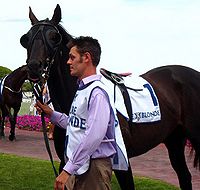
Australia is known as a sporting nation with success worldwide in swimming, tennis, rugby union, cricket, Formula One, V8 Supercars, netball and basketball. Australians are very keen at betting on horse races, with the Melbourne Cup[31] attracting up to 120,000 spectators at Flemington Race Course on the first Tuesday in November. There is a public holiday for the cup race in Melbourne, while the remainder of the country virtually pauses during the running.
Unique to Australia is a game known as Australian rules football or Aussie Rules, which is played on a cricket oval in winter. Australian rules football is the sport most attended in the states of Victoria, South Australia and Western Australia, and most attended overall in Australia; in 2006 2.5 million people had attended at least one Aussie Rules game in the preceding 12 months.[2] Australian Rules Football was written by persons educated at the Rugby School in England and Cambridge University before the organisation of uniform football codes. It is not as popular in New South Wales and Queensland although premiership teams are based in these two states and new teams from each have seen an increase in interest.
The other national football code is rugby league. Rugby league football is the most attended sport in New South Wales and Queensland with its premier club competition being the National Rugby League.
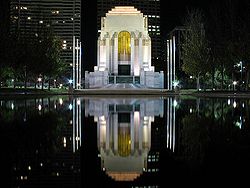
Tourism[edit]
Most tourists visit places such as Sydney Harbour, Uluru (Ayers Rock) in Central Australia and the Great Barrier Reef in Queensland. Other favourite destinations are the wine making areas of South Australia and northern Victoria, the Great Ocean Road in Victoria, the natural wonders of Tasmania and the huge outback expanses of Western Australia and the Northern Territory. Some cattle stations in Australia rival Texas in size and the distance between towns in some areas is enormous.
Gun control[edit]
In response to the 1996 Port Arthur massacre in which 35 people were killed (23 wounded) by a gunman, Australia introduced strict gun control laws. Due to bipartisan support the laws were quickly passed and a "gun buy-back" scheme was imposed, gun owners were forced to surrender their guns to the government in exchange for monetary compensation. As there is little to no "gun culture" in Australia, these measures were widely accepted and even welcomed. Since 1997 both the homicide rate and gun death rate in Australia have fallen dramatically.[Citation Needed]
Government[edit]

Australia became a federated nation on January 1, 1901 under the Constitution of Australia, and all former British colonies became states. The parliament met in Melbourne until the infrastructure was built for the capital city, Canberra.
Australia has a parliamentary system of government based on the British system with a bicameral system meeting as the Parliament of Australia, consisting of the Australian House of Representatives and the Australian Senate. Each state and territory also has its own parliament.
The two other branches of government under the Constitution are the Executive (Governor-General of Australia taking advice from the Ministers) and the judicial.
Australia is a democracy which has allowed men of European descent to vote since federation, with women gaining the vote in 1902 and Aboriginal men and women gaining suffrage in 1962. Voting is compulsory for all citizens who are 18 years old and over (with a few exceptions.)
Australia's Head of Government is the Prime Minister of Australia. The current Prime Minister is Anthony Albanese who is the leader of the Labor Party (a left-leaning political party).
The Head of State is Queen Elizabeth II, the Queen of Australia (who is the same person, but a different title, as the Queen of Great Britain.) Under the Constitution, and in practice, the authority of the Head of State is vested in the Governor-General of Australia, currently David Hurley AC, Previously Governor of New South Wales, who assents to acts of parliament, is the Commander in Chief of the military forces, and appoints all Ministers of the Government; all these various powers are normally exercised on advice from the Prime Minister.
The Government of Australia is exercised, day-to-day, by the Ministers through their various Departments of State.
Voting[edit]
For a more detailed treatment, see Voting in Australia.
Australia has preferential voting, and voting is compulsory for adults (18 years and over), unless they have been deemed unfit to vote, either by mental illness or conviction for serious offenses. Preferential voting encourages a multiplicity of parties and independent candidates, and counting the votes and allocating preferences can take some time where the results are close.
Terms[edit]
A Member of Parliament in the House of Representatives is elected for a maximum of three years, but the timing of elections is decided by the Governor-General on the advice of the Prime Minister.[32] A Member of Parliament in the Senate is typically elected for six years.[33] The Prime Minister is normally a member of the House of Representatives, and the tenure is not limited by statute. Ministers may continue to serve for up to three months when not a Member or Senator, but must in that time be elected in order to continue. (John Gorton was a Senator when appointed leader of his party after the death of his predecessor. He immediately resigned from the Senate and stood for election to the House of Representatives, while remaining Prime Minister throughout.)
Parliamentary political parties[edit]
Currently, the main political parties in Australia are:
- Australian Greens
- Australian Labor Party
- Family First Party
- Liberal Party of Australia
- National Party of Australia
- One Nation Party
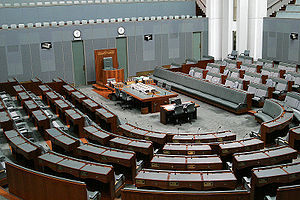
Despite the US connotation associated with the name, the Liberal Party is conservative in political stance. Robert Menzies helped found the Liberal Party in 1944 and was the Prime Minister from 1939 until 1941 and then again from 1949 until 1966.[34] The term "liberal" refers to the party's predominantly-free-market approach to economic management.
The party currently in power (since the 2022 Federal Election) is the Labor Party. The Liberal-National Coalition is also in government in New South Wales and Tasmania. The remainder of the states and territories are governed by the Labor party. The Prime Minister is the Labor, Anthony Albanese.
Conservative Queensland politician and businesswoman, Pauline Hanson formed the One Nation party to give a conservative voice to voters that were not being effectively represented by the major parties. One Nation has held seats in both the Federal Senate and Lower House, and have been the subject of ridicule by left-leaning media commentators.
Though the Labor party is "social democratic" and the Liberals are "liberal conservatives", some of the smaller parties are more left leaning or more conservative than Labor and Liberal respectively.
See also a list of Prime Ministers of Australia.
The Prime Minister of Australia is the most senior elected person in the country. The role is normally filled by the parliamentary leader of the party which forms the government.
Principal Government Officials[edit]
- Head of State—Queen Elizabeth II
- Governor General—David Hurley
- Prime Minister—Anthony Albanese
- Deputy Prime Minister—Richard Marles
- Treasurer—Jim Chalmers
- President of the Senate—Slade Brockman
- Leader of the Government (Senate)—Penny Wong
- Manager of Government Business (Senate)—Katy Gallagher
- Leader of the Opposition (Senate)—Simon Birmingham
- Manager of Opposition Business (Senate)—Anne Ruston
- Speaker of the House of Representatives—Andrew Wallace
- Leader of the House of Representatives—Tony Burke
- Manager of Opposition Business (House)—Paul Fletcher
- Chief Justice—Susan Kiefel
Political Conditions[edit]
Three political parties dominate the center of the Australian political spectrum. The Liberal Party (LP), nominally representing urban business interests, and its smaller coalition partner, The Nationals, nominally representing rural interests, are the more conservative parties. The Australian Labor Party (ALP) nominally represents workers, trade unions, and left-of-center groups. While the ALP, founded by labor unions, traditionally had been moderately socialist in its policies and approaches to social issues, today it is best described as a social democratic party. All political groups are tied by tradition to welfare programs. Over the last decade, Australia has increased welfare payments to families while imposing obligations on those receiving unemployment benefits and disability pensions. There is strong bipartisan sentiment on many international issues, including Australia's commitment to its alliance with the United States.
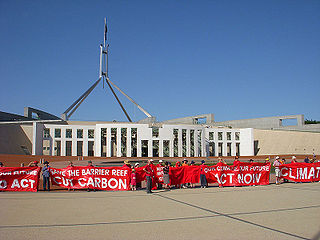
The ALP, under the leadership of Anthony Albanese, defeated the Liberal/National coalition, led by then-Prime Minister Scott Morrison, in the May 21, 2022 election. The ALP now holds 77 seats in the House of Representatives, against 58 for the Liberal/National coalition, and 16 Crossbench. The composition of the Senate is 32 seats for the coalition, 26 for the ALP, 12 seats for the Greens, two for One Nation, two for Lambie Network, one for United Australia and one independent.
The ALP won the election with a message promising "new leadership" after 11 years of the Howard government. Rudd portrayed himself as an "economic conservative," while criticizing unpopular Howard government policies on workplace relations reform, climate change, and the war on Iraq. The Rudd government ratified the Kyoto Protocol and is working with the international community on combating climate change. It is undoing some labor market reforms instituted by the Howard government, such as statutory individual contracts. The Australian government's foreign policy shows strong continuity with that of its predecessors, stressing relations with four key countries: the United States, Japan, China, and Indonesia. The Rudd government strongly supports U.S. engagement in the Asia-Pacific region and increased Australia's troop contribution in Afghanistan. It withdrew Australia's combat troops from Iraq in 2008; it intends to end its military mission in Iraq on July 31, 2009.
Australia has been an active participant in international affairs since federation in 1901, and Australian forces have fought beside the United States and other Allies in every significant conflict since World War I. On January 8, 1940, the governments of the United States and Australia announced the establishment of bilateral diplomatic relations. In 1944, Australia concluded an agreement with New Zealand dealing with the security, welfare, and advancement of the people of the independent territories of the Pacific (the ANZAC pact). After World War II, Australia played a role in the Far Eastern Commission in Japan and supported Indonesian independence during that country's revolt against the Dutch. Australia was one of the founding members of the United Nations, the South Pacific Commission, and the Colombo Plan. In addition to contributing to UN forces in Korea—it was the first country to announce it would do so after the United States—Australia sent troops to assist in putting down the 1948-1960 communist revolt in Malaya and later to combat the 1963-1965 Indonesian-supported invasion of Sarawak. The United States, Australia, and New Zealand signed the ANZUS Treaty in 1951, which remains Australia's pre-eminent formal security treaty alliance. Australia sent troops to assist South Vietnamese and U.S. forces in Vietnam, and joined coalition forces in the Persian Gulf conflict in 1991, in Afghanistan in 2001, and in Iraq in 2003.
Australia has been active in the Australia-New Zealand-U.K. agreement and the Five-Power Defense Arrangements—successive arrangements with Britain and New Zealand to ensure the security of Singapore and Malaysia.
One of the drafters of the UN Charter, Australia has given firm support to the United Nations and its specialized agencies. It was last a member of the Security Council in 1985–86, a member of the Economic and Social Council for 1986–89, and a member of the UN Human Rights Commission for 1994-96 and 2003–2005. Australia recently declared its intention to seek a non-permanent seat on the UN Security Council for 2013–2014. Australia takes a prominent part in many other UN activities, including peacekeeping, nonproliferation and disarmament negotiations, and narcotics control. Australia also is active in meetings of the Commonwealth Regional Heads of Government and the Pacific Islands Forum, and has been a leader in the Cairns Group—countries pressing for agricultural trade reform in World Trade Organization (WTO) negotiations—and in founding the APEC forum. In 2002, Australia joined the International Criminal Court.
Australia has devoted particular attention to relations between developed and developing nations, with emphasis on the ten countries of the Association of Southeast Asian Nations (ASEAN) and the island states of the South Pacific. Australia is an active participant in the ASEAN Regional Forum (ARF), which promotes regional cooperation on security issues, and has been a member of the East Asia Summit since its inauguration in 2005. In September 1999, acting under a UN Security Council mandate, Australia led an international coalition to restore order in East Timor upon Indonesia's withdrawal from that territory. In 2006, Australia participated in an international peacekeeping operation in Timor-Leste (formerly East Timor). Australia led a regional mission to restore law and order in Solomon Islands in 2003 and again in 2006. Australia is part of the Asia Pacific Partnership on Clean Development and Climate, which also includes the United States.
The government is committed to increasing official development assistance to 0.5% of gross national income by 2015–2016. Australia budgeted A$3.79 billion (U.S. $3.03 billion) for FY 2008-2009 and has budgeted A$3.82 billion (U.S. $3.05 billion) for FY 2009–2010. The Australian aid program is currently concentrated in Southeast Asia (Papua New Guinea and Indonesia are the largest recipients) and the Pacific Islands. Selected aid flows are allocated to Africa, South Asia, and reconstruction in Afghanistan and Iraq. Contributions to multilateral organizations and other expenses account for about one-third of the foreign assistance budget.
ANZUS and Defense[edit]
The Australia, New Zealand, United States (ANZUS) security treaty was concluded at San Francisco on September 1, 1951, and entered into force on April 29, 1952. The treaty bound the signatories to recognize that an armed attack in the Pacific area on any of them would endanger the peace and safety of the others. It committed them to consult in the event of a threat and, in the event of attack, to meet the common danger in accordance with their respective constitutional processes. The three nations also pledged to maintain and develop individual and collective capabilities to resist attack.
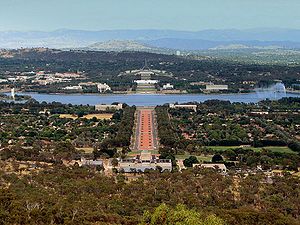
In 1984, the nature of the ANZUS alliance changed after the Government of New Zealand refused access to its ports by nuclear-weapons-capable and nuclear-powered ships of the U.S. Navy. The United States suspended defense obligations to New Zealand, and annual bilateral meetings between the U.S. Secretary of State and the Australian Foreign Minister replaced annual meetings of the ANZUS Council of Foreign Ministers. The first bilateral meeting was held in Canberra in 1985. At the second, in San Francisco in 1986, the United States and Australia announced that the United States was suspending its treaty security obligations to New Zealand pending the restoration of port access. Since 1985, U.S. Secretaries of State and Defense and the Australian Foreign and Defense Ministers have held 20 Australia-U.S. Ministerial consultations (AUSMIN), alternating between Australia and the United States. The next AUSMIN is scheduled to take place in Australia in 2010.
The U.S.-Australia alliance under the ANZUS Treaty remains in full force. AUSMIN meetings are supplemented by consultations between the U.S. Combatant Commander, Pacific and the Australian Chief of Defense Force. There also are regular civilian and military consultations between the two governments at lower levels.
ANZUS has no integrated defense structure or dedicated forces. However, in fulfillment of ANZUS obligations, Australia and the United States conduct a variety of joint activities. These include military exercises ranging from naval and landing exercises at the task-group level to battalion-level special forces training to numerous smaller-scale exercises, assigning officers to each other's armed services, and standardizing, where possible, equipment and operational doctrine. The two countries also operate joint defense facilities in Australia.
Following the terrorist attacks on the United States on September 11, 2001, then-Prime Minister Howard and U.S. President George W. Bush jointly invoked the ANZUS Treaty for the first time on September 14, 2001. Australia was one of the earliest participants in Operation Enduring Freedom. Australian Defense Forces participated in coalition military action against Iraq in Operation Iraqi Freedom. Australian combat forces began their withdrawal from Iraq in mid-2008 and forces are to be fully removed by July 2009. Australia has approximately 1,000 troops deployed in Afghanistan and also provides significant development and capacity building assistance to the country. Based on growing defense commitments, Australia decided to increase the Australian Army from 26,000 to 30,000 over the next several years. This will enable the reestablishment of two infantry battalions, as well as enabling troops, such as a new unmanned aerial vehicle (UAV) unit.
The Australian Government has stated its intention to maintain its investment in future capability of the Australian Defense Force (ADF). To do so, the government has committed to a 3% annual growth in real defense funding through 2018—and 2.2% annual real growth beyond—to ensure the ADF can continue to meet capability and interoperability goals. The Australian Defense Force numbers about 54,000 active duty personnel, with planned increases to 57,000 within the next decade. The Royal Australian Navy's (RAN) front-line fleet currently includes 12 frigates, including 4 of the Adelaide class and 8 Australian-built ANZAC class. In August 2004, Australia selected the Aegis Combat Control System for its three air warfare destroyers (AWD), which will start coming into service in 2014. The F/A-18 fighter, built in Australia under license from the U.S. manufacturer, is the principal combat aircraft of the Royal Australian Air Force, backed by the U.S.-built F-111 strike aircraft. In October 2002, Australia became a Level III partner in the U.S.-led Joint Strike Fighter (JSF) program. Additionally, the Australian Government signed the JSF Production, Sustainment and Follow-on Development MOU in 2006. Australia is projected to buy up to 100 JSF aircraft with deliveries starting in 2013 and running through 2020. The F-111 strike aircraft are scheduled to exit service by 2010 and will be replaced by 24 McDonnell Douglas F/A-18F Super Hornet fighters as an interim strike capability with deliveries commencing in 2010. The Royal Australian Air Force (RAAF) took delivery of the last aircraft in its buy of 4 Lockheed C-17 strategic airlift aircraft in 2008. In addition, Boeing will provide the Commonwealth of Australia's RAAF with an Airborne Early Warning and Control (AEW&C) system based on the Next-Generation 737-700 aircraft as the airborne platform. Recent U.S. sales to the Australian Army include the M1A1 AIM tank, as well as Hellfire and JAVELIN munitions. Future opportunities include CH-47 helicopter replacements, navy helicopter replacements, light and medium cargo aircraft replacements and artillery systems.
In May 2009, the Australian Government released its Defense White Paper, outlining Australia's long-term strategic outlook. In addition to buying the JSF aircraft, the White Paper proposes to double Australia's submarine fleet to 12, replace the ANZAC class frigates, and replace the army's armored personnel carriers.
Economy[edit]
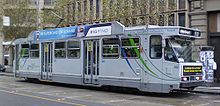
Since the 1980s, Australia has undertaken significant structural reform of its economy and has transformed itself from an inward-looking, highly protected, and regulated marketplace to an open, internationally competitive, export-oriented economy. Key economic reforms included unilaterally reducing high tariffs and other protective barriers to free trade, floating the Australian dollar, deregulating the financial services sector, including liberalizing access for foreign banks, increasing flexibility in the labor market, reducing duplication and increasing efficiency between the federal and state branches of government, privatizing many government-owned monopolies, and reforming the taxation system, including introducing a broad-based Goods and Services Tax (GST) and large reductions in income tax rates.
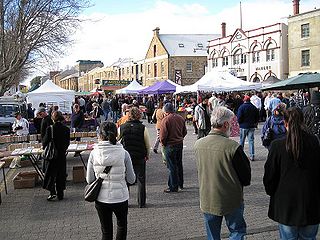
Australia enjoys a higher standard of living than any G7 country other than the United States. Australia's economic standing in the world is a result of a commitment to best-practice macroeconomic policy settings, including the delegation of the conduct of monetary policy to the independent Reserve Bank of Australia, and a broad acceptance of prudent fiscal policy where the government aims for fiscal balance over the economic cycle. Largely due to the fall in revenue as a result of the global economic downturn, net government debt is projected to reach about A$188 billion (U.S. $150.4 billion) in four years. The previous government, drawing from budget surpluses, created the “Future Fund” to provide for future liabilities resulting from the retirement of civil servants. The Government of Australia is predicting negative 0.5% growth in the 2009-2010 fiscal year; the International Monetary Fund (IMF) predicted growth to be negative 1.4% for 2009.
Over 2008, unemployment has risen to around 5.5% from 4.2%, and the labor market participation has remained at around 65%. Both the federal and state governments have recognized the need to invest heavily in water, transport, ports, telecommunications, and education infrastructure to expand Australia's supply capacity. The largest river system in Australia, the Murray-Darling, and related coastal lakes and wetlands in South Australia are critically threatened and the government has developed a plan to improve irrigation infrastructure and efficiency and buy back unused water allocations along the river.
- Nominal GDP: $1.35 trillion (2020)
- GDP per capita: $52,941 (2020)
- Inflation rate (year to March 2009): 2.5% per annum.
- Reserve Bank official interest rate (May 2009): 3.00%.
- Trade: Exports ($178.9 billion, 2008 estimate)--coal, iron ore, gold, meat, wool, alumina, wheat, machinery and transport equipment. Major markets—Japan, China, South Korea, U.S. ($10.7 billion), and New Zealand. Imports ($187.2 billion, 2008 estimate)--machinery and transport equipment, computers and office machines, telecommunication equipment and parts; crude oil and petroleum products. Major suppliers—China, United States ($23.96 billion), Japan, Singapore, and Germany.
- Exchange rate (May 2011): U.S. $1.05 = A$1
Australia is a developed country with a capitalist economy. It has a very small population compared to other Western countries like the USA and the UK but despite this, Australia is in the top 15 countries by GDP. Australia is currently the fourteenth-largest economy.
Exports and Imports[edit]
The economy of Australia is very different to that of other developed countries. For example, there is a nearly equal amount of exports compared to imports, which is generally not seen in Western Economies. This is mainly due to the fact that Australia is vast and rich in natural resources, and exports items such as coal, gold, meat, wool, iron ore, wheat and machinery. Australia has maintained trade links with various countries throughout history, but more recently with the economic boom of China and India exports (especially natural resources) have experienced a spike in growth. In 2008, China was 2nd while India was 4th on the Australian exports list, and China was 1st on Australia's Imports list.
Strong growth[edit]
Australia's strong trade market is generally attributed to its 2 decades of continuous growth at above average rates. This is really remarkable after considering the fact that there have been 2 recessions in that time frame (the early 2000s recession and the current recession). Australia is the only western nation that isn't in recession currently due to the Global Economic crisis. Australia's GDP reached over $1 trillion in the mid - late 2000's and this has been the result of the booming trade in some states like Western Australia where the exports account for twice as much value than their imports.
Businesses[edit]
Businesses are attracted to Australia for a number of factors which include:
- The fact that Australia is the fastest place in the world in which to start a business (according to the World Bank)
- Strategic location in the fast-growing Asia–Pacific region
- Economic and political stability
- A good and stable financial and legal system.
Unemployment[edit]
The unemployment rate in Australia is currently 5.5% and despite the global financial crisis, the unemployment rate had never gone over 6%, instead peaking at at only 5.8% in October 2009. This is unlike the US where the unemployment rate went over 10% despite massive stimulus. [3] [4]
Resources[edit]
Australia has lots of natural resources; they especially have a high number of energy.
Energy[edit]
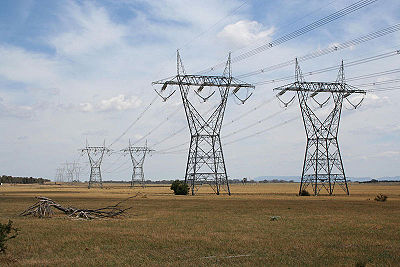
Australia is rich in natural resources with significant petroleum, natural gas and coal reserves. Australia's energy consumption is dominated by coal, which fuels most of the country's power generation. Petroleum accounts for a large share of energy consumption, but due to declining output, Australia is facing a growing dependence on petroleum imports. Over the past two decades, Australia has steadily consumed increasing amounts of natural gas, which is likely to continue over the medium term.[35]
Australia is one of the four countries (along with Norway, Canada and Mexico) belonging to the Organization for Economic Cooperation and Development (OECD) that is a significant net energy exporter. Australia is the world's largest coal exporter and is the fifth largest exporter of liquefied natural gas (LNG). Australia's prospects for expanding energy exports in the future are promising as Asian demand for both coal and LNG rises. However, Australia can expect increasing export competition from China (coal) and Indonesia (coal and LNG).
In July 2005, the Australian government formed the Australian Energy Regulator (AER). The AER is responsible for economic regulation in Australian energy markets. In addition, the AER promotes investment in the energy sector to ensure supply security, while monitoring prices faced by end users. In 2006, Australia's 13 government bodies transferred energy regulation responsibility to the AER. The AER is seeking $23 billion in infrastructure investments over the next 15 years.
Comparing Australian and U.S. Economic and Health statistics[edit]
Whilst the Australian society is similar in many aspects to those of the U.S., a comparison of key economic (in $U.S.) and health indicators highlights some interesting fundamental differences:
| Australia | U.S. | |
|---|---|---|
| GDP Per Capita | $32,900.00 | $43,500.00 |
| Budget Deficit/Surplus Per capita |
$444.00 surplus. Australia has had budget surpluses every year since 2001 |
$841.00 deficit |
| Public Debt | 14.1% of GDP | 64.7% of GDP |
| Military Expenditure | 2.5% of GDP | 4.06% of GDP |
| Life Expectancy at Birth (combined male and female) |
80.5 years | 77.85 years |
| Infant Mortality Rates deaths/1,000 live births |
4.63 | 6.43 |
| HIV/AIDS Prevalence Rates | 0.1% of population | 0.6% of population |
Australia has a universal health scheme and significant subsidies on most prescription medications.
History[edit]
See main article History of Australia
Australia was uninhabited until stone-culture peoples arrived, perhaps by boat across the waters separating the island from the Indonesia archipelago more than 40,000 years ago. Portuguese, Spanish, Dutch, and English explorers observed the island before 1770, when Captain Cook explored the east coast and claimed it for Great Britain.
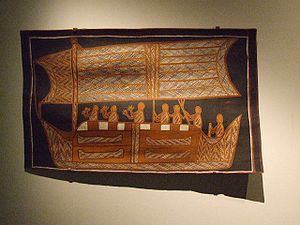
On January 26, 1788 (now celebrated as Australia Day), the so-called First Fleet landed at Sydney and the Colony of New South Wales was established. Many, but by no means all, of the first settlers were convicts, some condemned for offenses that today would often be thought trivial. From the mid-19th century convict transportation to Australia significantly declined; the last ship to arrive was in 1868. Many officers of the Royal Navy received grants and established large farms and ranches. Ranchers who used government lands for their herds of sheep were informally called "squatters"; despite the term, most were wealthy. The discovery of gold in 1851 led to increased immigration, wealth, and trade. A third of the new arrivals were Irish Catholics, and there emerged a political and cultural tension between them and the Protestant British.
The six colonies that became the states of the Australian Commonwealth were established in the following order: New South Wales, 1788; Tasmania, 1825; Western Australia, 1829; South Australia, 1836; Victoria, 1851; and Queensland, 1859. Settlement preceded these dates in most cases.
Negotiations between Australians and the government in London led Parliament to create the Commonwealth of Australia in 1900, effective January 1, 1901.
Australia came of age in World War I, when it supported the British war effort, and imprisoned German citizens living there. The great defeat at Gallipoli focused Australia's heroes self-image.
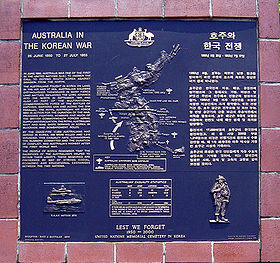
In May 1927, the seat of government was transferred to Canberra, a planned city designed by American Walter Burley Griffin. Australia passed the Statute of Westminster Adoption Act on October 9, 1942 (with effect as of September 3, 1939), which officially established Australia's complete autonomy in both internal and external affairs and formalized a situation that had existed for years.[36]
In World War II Australia again rallied to the British cause, but were left practically undefended when at fall of Singapore in 1942 the Japanese captured much of the Australian army. The rest of the army was rushed back from the Middle East to defend against a possible Japanese invasion. Britain was no help, so Australia turned, permanently, to the United States for its defense.
In practice the monarch is only symbolic—a symbol especially of ties to the British Empire that the Irish and new immigrants are unwilling to continue. In 1998,republicans were given a free hand to choose the form of republic they wanted. This was put to a referendum in 1999, and enjoyed strong support among the politicians and in the mainstream media. But a campaign led by a group, Australians for Constitutional Monarchy resulted in the defeat of the referendum in all states and 72% of electorates. Republicans remain unable to agree on how to replace the present system—whether with a powerful elected president responsible directly to the people, or with a weak president chosen by the government (as in Germany), the model which was rejected in 1999 because of distrust of politicians.
See also[edit]
- Australian dollar
- Currency: Australia
- Australia, irreligion and obesity
- Irreligious Australia and alcoholism
Bibliography[edit]
References[edit]
- Bambrick, Susan ed. The Cambridge Encyclopedia of Australia (1994)
- Davison, Graeme, John Hirst, and Stuart Macintyre, eds. The Oxford Companion to Australian History (2001) online at many academic libraries; also excerpt and text search
- O'Shane, Pat et al. Australia: The Complete Encyclopedia (2001)
- Shaw, John, ed. Collins Australian Encyclopedia (1984)
- Serle. Percival, ed. Dictionary of Australian Biography (1949) online edition

Guides[edit]
- Australia For Dummies by Marc Llewellyn and Lee Mylne. (2008) excerpt and text search
- Central Australia: Adelaide to Darwin by Charles Rawlings-Way and Meg Worby (2009) excerpt and text search
- Frommer's Australia 2009 by Lee Mylne et al. (2008) excerpt and text search
- Moon Living Abroad in Australia by James M. Lane (2008) excerpt and text search
- The Rough Guide to Australia by Margo Daly et al. (2009) excerpt and text search
- Vaisutis, Justine et al. Lonely Planet Sydney & New South Wales (2009) excerpt and text search
Economics and business[edit]
- Kelly, Paul. The End of Certainty: Power, Politics and Business in Australia, (1994)
- McLean, Ian W. "Consumer Prices and Expenditure Patterns in Australia 1850-1914." Australian Economic History Review(1999) 39(1): 1-28; includes a consumer price index (CPI) for the period 1850 to 1914. Issn: 0004-8992 Fulltext: Ebsco
- Moran, Anthony. Australia: Nation, Belonging, and Globalization Routledge, 2004 online edition
- Robinson GM, Loughran RJ, and Tranter PJ. Australia and New Zealand: economy, society and environment.(2000)
Environment and Geography[edit]
- Appleton, Richard, and Barbara Appleton. The Cambridge Dictionary of Australian Places (1993)
- Dovers, Stephen. Australian Environmental History: Essays & Cases (1995) excerpt and text search
- Garden, Don. Australia, New Zealand, and the Pacific: An Environmental Hisory. ABC-CLIO, 2005. 398 pp.
- Hutton, Drew, and Libby Connors. History of the Australian Environment Movement (1999) excerpt and text search
- Lines, William. Taming the Great South Land: A History of the Conquest of Nature in Australia (1992)
- Powell JM . An Historical Geography of Modern Australia: The Restive Fringe. (1988)
- Robinson GM, Loughran RJ, and Tranter PJ. Australia and New Zealand: economy, society and environment.(2000)
History[edit]
see History of Australia for more detaile guide
- Atkinson, Alan. The Europeans in Australia: A History. Vol. 2: Democracy. (2005). 440 pp.
- Barker, Anthony. What Happened When: A Chronology of Australia from 1788. Allen & Unwin. 2000. online edition
- Basset, Jan. The Oxford Illustrated Dictionary of Australian History (1998)
- Bolton, Geoffrey. The Oxford History of Australia: Volume 5: 1942-1995. The Middle Way (2005)
- Clarke, Frank G. The History of Australia (2002). online edition
- Davison, Graeme, John Hirst, and Stuart Macintyre, eds. The Oxford Companion to Australian History (2001) online at many academic libraries; also excerpt and text search
- Day, David. Claiming a Continent: A New History of Australia (2001);
- Edwards, John. Curtin's Gift: Reinterpreting Australia's Greatest Prime Minister, (2005) online edition
- Hughes, Robert. The Fatal Shore: The Epic of Australia’s Founding (1988). excerpt and text search
- Kemp, Rod, and Marion Stanton, eds. Speaking for Australia: Parliamentary Speeches That Shaped Our Nation Allen & Unwin, 2004 online edition
- Kingston, Beverley. The Oxford History of Australia: Volume 3: 1860-1900 Glad, Confident Morning (1993)
- Kociumbas, Jan. The Oxford History of Australia: Volume 2: 1770-1860 Possessions (1995)
- Macintyre, Stuart. The Oxford History of Australia: Volume 4: 1901-42, the Succeeding Age (1993)
- Macintyre, Stuart. A Concise History of Australia (2nd. ed. 2009) excerpt and text search
- Martin, A. W. Robert Menzies: A Life (2 vol 1993–99), online at ACLS e-books
- Megalogenis, George. The Longest Decade (2nd ed. 2009), politics 1990-2008
- Schreuder, Deryck, and Stuart Ward, eds. Australia's Empire (Oxford History of the British Empire Companion Series) (2008) excerpt and text search
- Serle. Percival, ed. Dictionary of Australian Biography (1949)online edition
- Taylor, Peter. The Atlas of Australian History (1991)
- Welsh, Frank. ;;Australia: A New History of the Great Southern Land (2008)
International Relations and Military[edit]
- Bridge, Carl ed., Munich to Vietnam: Australia's Relations with Britain and the United States since the 1930s, Melbourne University Press 1991
- Dennis, Peter, Jeffrey Grey, Ewan Morris, and Robin Prior. The Oxford Companion to Australian Military History. (1996)
- Firth, Stewart. Australia in International Politics: An Introduction to Australian Foreign Policy (2005) online edition
- Grant, Ian. A Dictionary of Australian Military History - from Colonial Times to the Gulf War (1992)
- Lee, David. Search for Security: The Political Economy of Australia's Postwar Foreign and Defence Policy (1995)
- McLean, David. "From British Colony to American Satellite? Australia and the USA during the Cold War," Australian Journal of Politics & History" (2006) 52 (1), 64–79. Rejects satellite model. online at Blackwell-Synergy
- McLean, David. "Australia in the Cold War: a Historiographical Review." International History Review (2001) 23(2): 299–321. Issn: 0707-5332
- Murphy, John. Harvest of Fear: A History of Australia's Vietnam War (1993)
- Watt, Alan. The Evolution of Australian Foreign Policy 1938–1965, Cambridge University Press, 1967
Culture and society[edit]
- Bebbington, Warren. A Dictionary of Australian Music (1999)
- Bennett, Bruce et al. The Oxford Literary History of Australia (1999)
- Bennett, Tony, and David Carter. Culture in Australia: Policies, Publics and Programs (2001) excerpt and text search
- Breward, Ian. A History of the Churches in Australasia. (2002). 474 pp.
- Carey, Hilary. Believing in Australia: A Cultural History of Religions (1996)
- Horton, David. The Encyclopedia of Aboriginal Australia: Aboriginal and Torres Strait Islander History, Society and Culture (2001)
- Huggan Graham. Postcolonialism, Racism, Transnationalism (Oxford Studies in Postcolonial Literatures) (2007) excerpt and text search
- Jupp, James, ed. The Australian People: An Encyclopedia of the Nation, its People and their Origins (2nd ed. 2002) 960pp excerpt and text search
- Jupp, James. The English in Australia (2004) excerpt and text search
- Kleinert, Sylvia. and Margo Neale. The Oxford Companion to Aboriginal Art and Culture (2001)
- Leitner, Gerhard. Australia's Many Voices: Australian English--the National Language (2004) excerpt and text search
- Love, J.W. ed. Australia and the Pacific Islands (Garland Encyclopedia of World Music, Volume 9) (1998) excerpt and text search
- McAllister, Ian, Steve Dowrick, Riaz Hassan; The Cambridge Handbook of the Social Sciences in Australia Cambridge University Press, 2003 online edition
- McCulloch, Alan. Encyclopedia of Australian Art 2 vol (1984)
- McDonald, John. Federation: Australian Art and Society, 1901-2001. Natl. Gallery of Australia, 2002. 264 pp.
- Moran, Albert. Historical Dictionary of Australian Radio and Television (2007)
- Nile, Richard. The Making of the Australian Literary Imagination. (2002). 315 pp.
- Rickard, John, Australia: A Cultural History (1988)
- Webby, Elizabeth. The Cambridge Companion to Australian Literature (2000) excerpt and text search
- Wilde, William H. et al eds. The Oxford Companion to Australian Literature (1995) online at OUP excerpt and text search
- The Oxford Literary History of Australia.
- Samuels, Selina, ed. Australian Writers, 1915–50. (2002). 510 pp.
- Sayers, Andrew. Australian Art (2001) excerpt and text search
- Webby, Elizabeth, ed. The Cambridge Companion to Australian Literature (2006)
- Wannan, Bill. A Dictionary of Australian Folklore: Lore, Legends, Myths and Traditions (1988)
Primary sources[edit]
- Australia: Literature and History 136 e-books
External links[edit]
- Australian Government portal
- Australian Parliament House (Reps & Senate) portal
- Governor-General of Australia
- Australia and Oceania
- Australians for Constitutional Monarchy
- The Crowned Republic
References[edit]
- ↑ https://www.gold.org/goldhub/data/gold-production-by-country
- ↑ "Australia produces 19 useful minerals in significant amounts, from over 350 operating mines. ... Australia is one of the world's leading producers of bauxite (aluminum ore), iron ore, lithium, gold, lead, diamond, rare earth elements, uranium, and zinc. Australia also has large mineral sand deposits of ilmenite, zircon and rutile. In addition, Australia produces large quantities of black coal, manganese, antimony, nickel, silver, cobalt, copper and tin. Mining occurs in all states of Australia, the Northern Territory and Christmas Island." [1]
- ↑ This refers just to the Australian mainland. Some authorities now include Papua New Guinea, New Zealand, and various other Pacific Ocean islands in the continent of "Oceania". See WorldAtlas.com.
- ↑ Some people count six, combining North and South America or Europe and Asia. See WorldAtlas.com.
- ↑ ABS
- ↑ http://www.abs.gov.au/ausstats/abs@.nsf/mf/3101.0 Australian Bureau of Statistics
- ↑ Munro, Neil (April 20, 2017). Australian Gov’t Adopts ‘Extreme Vetting’ for Islamic Migrants, Reforms Foreign Worker Visas. Breitbart News. Retrieved April 20, 2017.
- ↑ Multiple references:
- Remeikis, Amy (July 24, 2018). Dutton says Australia won't 'surrender our sovereignty' by signing UN migration deal. The Guardian. Retrieved July 27, 2018.
- Riordan, Primrose (July 25, 2018). Peter Dutton says he will not sign UN agreement on migration ‘in its current form’. The Australian. Retrieved July 27, 2018.
- Kan, Janita (July 25, 2018). Australia Will Not Sign UN Global Migration Agreement ‘In Its Current Form’. The Epoch Times. Retrieved July 27, 2018.
- ↑ Kent, Simon (November 19, 2018). ‘Enough, Enough, Enough’: Australia Ready to Slash Migrant Intake. Breitbart News. Retrieved November 19, 2018.
- ↑ Packham, Colin (March 19, 2019). Australia cuts annual immigrant cap, puts key cities off-limits to some. Reuters. Retrieved June 30, 2019.
See also:- Kelly, Lidia (October 26, 2019). Australia to settle more immigrants outside major cities. Reuters. Retrieved October 26, 2019.
- Koziol, Michael (November 22, 2019). Government wants half of new refugees to be settled in 'regional' Australia by 2022. The Sydney Morning Herald. Retrieved November 24, 2019.
- ↑ Kent, Simon (September 5, 2019). Skilled Workers Preferred: Permanent Migration To Australia Falls to Lowest Level in a Decade. Breitbart News. Retrieved September 5, 2019.
- ↑ Kent, Simon (December 4, 2019). Australia Wants Migrants to Speak English, ‘Fully Integrate’ and Pledge Allegiance. Breitbart News. Retrieved December 4, 2019.
- ↑ 13.0 13.1 13.2 13.3 13.4 Dawson, Stephan (August 28, 2015). How Australia Stopped Illegal Immigration. Ricochet. Retrieved August 18, 2016.
- ↑ Kent, Simon (May 30, 2018). Toughened Border Security Drives Plunge in Australia’s Migration Intake. Breitbart News. Retrieved May 30, 2018.
- ↑ Kent, Simon (July 13, 2018). Tougher Border Controls Crash Australia’s Migrant Numbers to 10-Year Low. Breitbart News. Retrieved July 13, 2018.
- ↑ Kent, Simon (August 24, 2018). Hardline Border Security Advocate Scott Morrison Australia’s New PM. Breitbart News. Retrieved August 24, 2018.
- ↑ Pannett, Rachel (August 24, 2018). Australia Ousts Another Prime Minister as Ruling Party Shifts Right. The Wall Street Journal. Retrieved August 24, 2018.
- ↑ Nauru could thwart refugee medical transfers to Australia. Reuters. February 19, 2019. Retrieved February 19, 2019.
- ↑ Pinkerton, James P. (May 19, 2019). Pinkerton: Immigration Curbs Key to Conservative Victory in Australia and a Lesson for Trump. Breitbart News. Retrieved May 20, 2019.
- ↑ Kent, Simon (July 17, 2019). Australia Rejects Call to Open Borders, Soften Illegal Immigration Stand. Breitbart News. Retrieved July 17, 2019.
- ↑ Packham, Colin (December 3, 2019). Australia restricts medical transfer of refugees from Pacific camps. Reuters. Retrieved December 3, 2019.
- ↑ https://www.theguardian.com/world/2020/apr/28/australia-called-gum-stuck-to-chinas-shoe-by-state-media-in-coronavirus-investigation-stoush
- ↑ https://theconservativetreehouse.com/blog/2021/09/02/premier-gladys-berejiklian-of-the-new-south-wales-directorate-has-a-warning-message-for-australian-citizens-demanding-freedom/
- ↑ https://www.americanthinker.com/blog/2021/08/australia_has_gone_stark_raving_mad.html
- ↑ https://www.newstarget.com/2021-10-12-gladys-berejiklian-bribed-blackmailed-big-pharma-vaccine.html
- ↑ https://nationalfile.com/australian-government-to-seize-24000-children-vaccinate-them-without-parents-present-in-massive-stadium/
- ↑ https://www.newstarget.com/2021-08-19-australia-runs-mass-child-sacrifice-luciferian-vaccine-ritual-targeting-24000-children-warning-graphic.html
- ↑ https://theconservativetreehouse.com/blog/2021/09/22/melbourne-australia-police-and-riot-squads-fire-upon-peaceful-protestors-while-media-frame-covid-anti-lockdown-protests-as-domestic-extremists/
- ↑ https://www.brisbanetimes.com.au/national/queensland/banks-raided-property-seized-licences-cancelled-in-covid-cost-recovery-20211027-p593kz.html
- ↑ National Church Life Survey 2004; U.S. State Department, "International Religious Freedom Report 2008" online
- ↑ Melbourne Cup
- ↑ Parliament of Australia: Senate: Constitution - Chapter 1 Part III. Retrieved on 2010-10-13.
- ↑ Parliament of Australia: Senate: Constitution - Chapter 1 Part II. Retrieved on 2010-10-13.
- ↑ History of the Liberal Party in Australia
- ↑ See Energy Information Administration, "Australia" (2009) online
- ↑ The Australia Act (effective March 3, 1986) eliminated almost all remaining vestiges of British legal authority, including the ability to appeal to the British Privy Council.
| Copyright Details | |
|---|---|
| License: | Some of the text for this article is in the Public Domain in the United States because it is a work of the United States Federal Government under the terms of Title 17, Chapter 1, Section 105 of the U.S. Code |
| Source: | File available from the United States Federal Government [5]. |
Categories: [Oceanian Countries] [Continents] [Australia] [Christian-Majority Countries] [British Empire] [Bibliographies]
↧ Download as ZWI file | Last modified: 02/19/2023 15:22:16 | 278 views
☰ Source: https://www.conservapedia.com/Australia | License: CC BY-SA 3.0
 ZWI signed:
ZWI signed: KSF
KSF